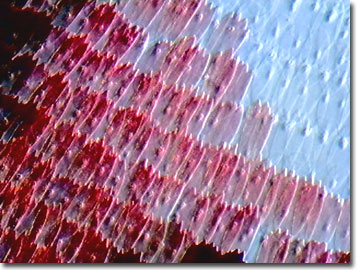Butterfly Wing Scale Digital Image Gallery
Great Orange Tip Butterfly
Aptly named, the great orange tip butterfly bears bright white wings that are marked with an orange area along the upper edge of the forewings. Specimens are captured for collectors in the wilds of Asia, but are also reared in captivity. The relatively common butterflies, scientifically referred to as Hebomoia glaucippe, are often released at weddings and used for live displays.

The largest of the lepidopteran family Pieridae found in Asia, the great orange tip butterfly is represented by 27 subspecies. The females are darker than the male butterflies and feature additional black wing markings. In stark contrast to the bright upper surfaces, the undersides of the wings and body of the great orange tip adult closely mimic the appearance of a leaf. Depending on the subspecies, the butterfly may appear either a dried brown or a live green marked with a highly detailed midrib and branching vein design. When at rest, the great orange tip butterfly holds its wings still in the upright position and remains well hidden from predators in the Asiatic forests.
One of the speediest butterflies, the great orange tip tends to fly in the morning and prefers the fringes of forests, rather than their centers. The lepidopterans also frequent wetlands, the males congregating during the heat of the day on the moist ground to gather salts and other nutrients essential for successful reproduction. Females, on the other hand, seldom leave the cover of the tropical forest. Despite their great numbers, adult members of the species are very hard to catch because they are such powerful fliers.
In the larval stage, great orange tip butterflies are not especially large or speedy. The caterpillars tend to move slowly, methodically feeding upon the leaves of Capparidaceae plants, including the garlic pear. The newly hatched larvae are a khaki green color and are covered with numerous long, stiff, white or clear spine-like bristles. Caterpillars in the later stages lose their body bristles, transform into a blue-green color, and feature a pair of thoracic red and blue false eyespots, which help them to deceive potential predators. When startled, a great orange tip caterpillar swells its thorax and thrashes around in a defensive behavior that makes it appear much larger than it really is.
Great Orange Tip Butterfly Images in Brightfield Illumination
Wing Scales and Fur (High Magnification) - The jagged edges of a great orange tip butterfly's wing scales are beautifully displayed in this brightfield image. A few strands of the fur that coats the wings appears thin and wispy in contrast.
Great Orange Tip Butterfly Images in Oblique Illumination
Wing Scale Array - This splendid image captured in oblique light reveals the fact that the wing scales of a great orange tip butterfly are not perfectly smooth. Small bumps are clearly displayed among the many rows of overlapping scales.
Great Orange Tip Butterfly Images in Reflected Light
Wing Scales and Fur (Low Magnification) - The great orange tip wing scales displayed in this image have a grayish hue and are highlighted by a fine white fur.
Upper Side of Wing - This photomicrograph displays row upon row of delicate white scales, a characteristic feature of the upper side of great orange tip butterfly wings.
Underside of Wing - The underside of great orange tip wings may vary in color, but are generally reminiscent of leaves. This reflected light image displays a pair of wing veins surrounded by black and green scales.
Contributing Authors
Cynthia D. Kelly, Shannon H. Neaves, Laurence D. Zuckerman, and Michael W. Davidson - National High Magnetic Field Laboratory, 1800 East Paul Dirac Dr., The Florida State University, Tallahassee, Florida, 32310.
BACK TO THE BUTTERFLY WING SCALE IMAGE GALLERY
BACK TO THE DIGITAL IMAGE GALLERIES
Questions or comments? Send us an email.
© 1995-2022 by Michael W. Davidson and The Florida State University. All Rights Reserved. No images, graphics, software, scripts, or applets may be reproduced or used in any manner without permission from the copyright holders. Use of this website means you agree to all of the Legal Terms and Conditions set forth by the owners.
This website is maintained by our
Graphics & Web Programming Team
in collaboration with Optical Microscopy at the
National High Magnetic Field Laboratory.
Last Modification Friday, Nov 13, 2015 at 02:19 PM
Access Count Since January 21, 2003: 23789
Visit the website of our partner in introductory microscopy education:
|
|
